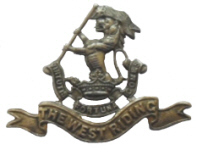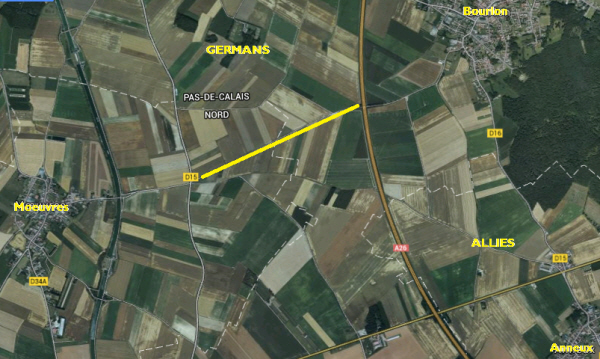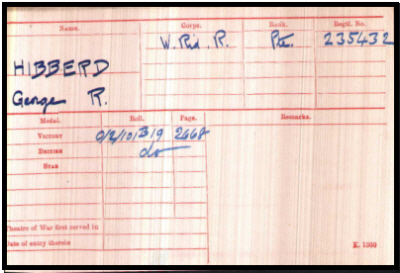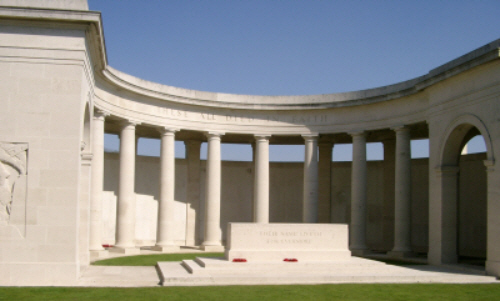



No.235432, Private, George Robert HIBBERD
Aged 36

|
George Robert Hibberd was born in Newmarket in Q2-1880 [Newmarket 3b:579](transcribed as HIBBERT) the 4th son of Samuel and Eliza Kate HIBBERD (nee JOHNSON),
of 4 York Terrace, Exeter Road, Newmarket. 1881 census...George [?] was at 4 York Terrace with his father Samuel [42] stableman born Salisbury, his mother Eliza [37] born Temple Patrick, Ireland and his brothers Samuel J [15] born Alfriston, Sussex, Frederick H [13]; Arthur E [11] and Tom A J [9] all born in Newmarket, as were his sisters Grace [7] and Alice M [4]. His father died in Newmarket in 1888. 1891 census...George [10] was at 17 Lisburn Road, Newmarket with his widowed mother and 5 siblings (Samuel; Arthur; Grace; Alice and younger brother Albert [8] born in Fordham. 1901 census...George [20] was now a grocers assistant, and the family (as in 1891) were still at 17 Lisburn Road. His mother died in Q3-1901 in Newmarket. 1911 census...George [30] was odd Job Man at the Jockey Club Kitchen, High Street, Newmarket. He married Mary Ann DOVER (b.29-9-1887) on the 8th August 1914 in Burwell, they lived in Burwell. His widow and children on the pension card were at Ash Tree Cottages, North Street Burwell. Olive Mary was born 22-10-1915 and Tom William George was born on 1-9-1917
His widow Mary Ann re-married, to Percy Leonard BOND, at St Mary's Church, Burwell in 1922.
|

|
George enlisted in Maidstone in Kent. His battalion landed in France January 1917. As part of the Battle of Cambrai, the final assault on Bourlon was carried out by the 'refreshed' 62nd Division on Tuesday the 27th of November. By this time snow had fallen, however, on the day that the assault had gone in the snow had turned to rain. Accompanied by nineteen tanks the Division's 186th and 187th Brigades had begun their assault in the wake of a bombardment of the village with shrapnel and high explosives which had begun at 6-30 that morning. On the left, the men of 187th Brigade's 2/5th York and Lancaster's and 2/5th King's Own Yorkshire Light Infantry had been led towards the ravaged village by eleven tanks and had soon run into strong barbed wire defences which had been untouched by the bombardment. Here the two battalions had been cut to pieces, especially the KOYLI, by a veritable hurricane of machine gun and rifle fire, whilst ten of their tanks had been disabled by shell fire [during the attack five of the nineteen tanks had literally been lost, never to be seen again]. On the right of the assault, Bradford's elite 186th Brigade had fared little better, the three battalion's of Duke of Wellington's being stopped in their tracks by the intense fire having achieved none of their objectives. During that afternoon the Germans had mounted their inevitable counter attack, which had caused all the attacking force to be withdrawn to the high ground in the rear. Once again the 62nd Division had been unable to capture Boulon and could do no more. The Division had eventually been relieved, during a bombardment of gas shells, by the 47th Division on the 28th of November. By this time the division had lost one hundred and fifty four officers and three thousand one hundred and seventy eight other ranks. 20 of the West Riding Regiment died on 26th November 1917, none have identified graves and all are named on the Cambrai Memorial This was the first major use of tanks, a logistical nightmare as the tanks alone (almost 400 were planned to take part) needed over 165,000 gallons of petrol and 75,000 pounds of grease, 500,000 rounds of ammunition for their six pounder [57mm] guns together with over five million rounds of machine gun ammunition. The 2nd/5th Battalion war diary has:- 25th Nov 1917 - 1:30 pm Battalion marched into support in SUNKEN ROAD NW ANNEUX. 2/Lt Liddle and 4 O/R wounded. 26th Nov 1917 - Battalion in support. 7:30 pm moved to take over the line in BOURLON WOOD from the 2nd/7th D of W Regiment and prepare for attack on the following day. Their objective was the German line along the Mouevres-Bourlon road from where it crosses the D15, to where it now crosses over the motorway., see below |



click here to go to the Commonwealth War Graves Commission website for full cemetery/memorial details